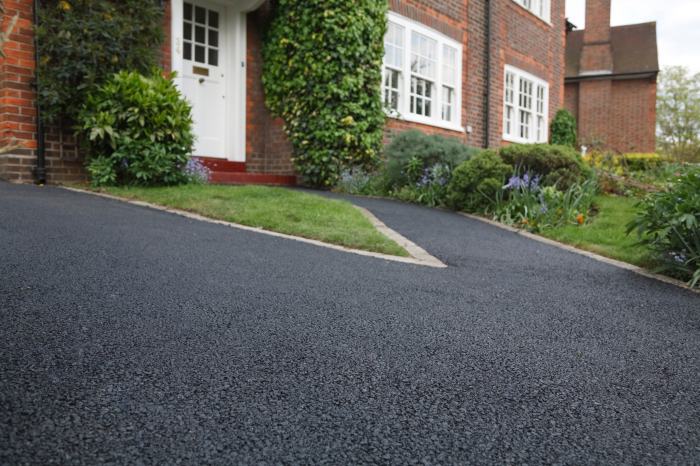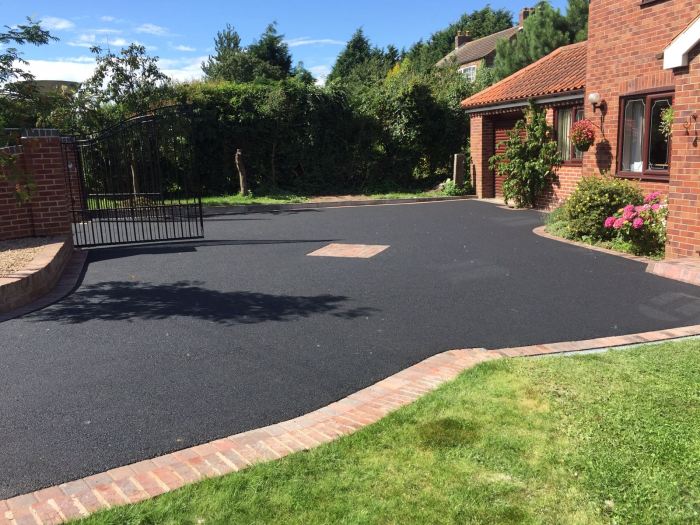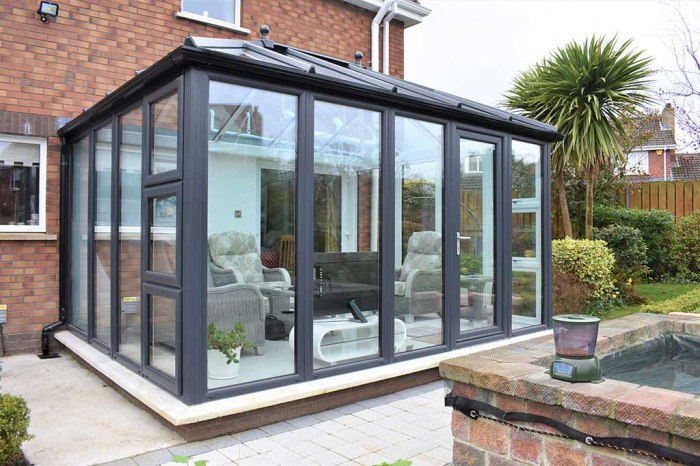Prepare to be captivated as we dive into the world of tarmac drive ideas! From sleek geometric patterns to warm, inviting finishes, this guide will inspire you to transform your driveway into a masterpiece. Get ready to elevate your curb appeal and create a lasting impression.
Tarmac, a versatile material known for its durability and affordability, offers endless possibilities for driveway design. Explore various surface finishes, from smooth and textured to imprinted, and discover how they can enhance the aesthetics of your property.
Tarmac Drive Materials and Finishes
Tarmac driveways, also known as asphalt driveways, offer a durable and versatile solution for residential and commercial properties. They are constructed using a combination of materials, each with its unique properties and advantages. Here’s a comprehensive overview of the materials used in tarmac drive construction:
Asphalt
Asphalt is a popular choice for tarmac driveways due to its durability, cost-effectiveness, and ease of maintenance. It is a mixture of crushed stone, sand, and bitumen, a sticky black substance that binds the aggregate together. Asphalt driveways are available in a variety of thicknesses, depending on the intended use and traffic volume.
Thicker asphalt layers provide greater durability and longevity.
Concrete
Concrete is another common material used in tarmac drive construction. It is a mixture of cement, sand, and gravel, which is poured into forms and allowed to harden. Concrete driveways are known for their strength and durability, but they can be more expensive than asphalt and require more maintenance.
They are also more prone to cracking, especially in areas with extreme temperature fluctuations.
Resin-Bound
Resin-bound driveways are a relatively new type of tarmac driveway that offers a unique combination of durability, aesthetics, and ease of maintenance. They are made from a mixture of natural stone aggregates and a clear resin binder. Resin-bound driveways are highly porous, allowing water to drain through, reducing the risk of puddling and ice formation.
They are also resistant to cracking and fading, making them a low-maintenance option.
Surface Finishes
In addition to the materials used, tarmac driveways can be finished in a variety of textures and patterns to enhance their appearance and functionality. Here are the most common surface finishes:
Smooth
Smooth finishes provide a classic, clean look and are easy to clean and maintain. They are ideal for areas with light to moderate traffic.
Textured
Textured finishes add a bit of visual interest and can help to improve traction, especially in wet or icy conditions. They are a good choice for driveways with slopes or areas with heavy traffic.
Imprinted
Imprinted finishes allow you to create custom designs and patterns in your driveway. They are achieved by pressing a mold into the fresh asphalt while it is still pliable. Imprinted finishes can add a touch of elegance and sophistication to your property.
Tarmac Drive Design Ideas
Tarmac driveways offer a wide range of design possibilities, from classic to contemporary. With careful planning and execution, you can create a driveway that enhances the aesthetics of your property and complements its architectural style.
Geometric patterns, borders, and contrasting colors can add visual interest to your driveway. Curves and slopes can create a sense of movement and depth, while incorporating features like lighting and water elements can enhance the overall design.
Drainage Considerations
Proper drainage is crucial for the longevity of your tarmac driveway. Water can cause damage to the surface and base materials if it is not properly managed. Incorporating drainage channels, slopes, and soakaways into the design will help prevent water from pooling and causing problems.
Tarmac Drive Edging Options
Edging defines the perimeter of your tarmac drive, providing both a practical and aesthetic function. Choosing the right edging material can enhance the overall appearance and durability of your drive.
There are various edging materials available, each with its own advantages and disadvantages. Let’s explore the different options:
Concrete Edging
- Pros:Durable, long-lasting, and can be customized to match the color and texture of your tarmac drive.
- Cons:Requires professional installation, can be expensive, and may crack over time if not properly installed.
Metal Edging
- Pros:Durable, rust-resistant, and easy to install. Available in various styles and colors to complement your drive.
- Cons:Can be more expensive than other options, and may not be as aesthetically pleasing as some other materials.
Plastic Edging
- Pros:Flexible, easy to install, and affordable. Available in a range of colors and styles.
- Cons:Not as durable as concrete or metal, and may become brittle over time.
Other Edging Options
In addition to the materials mentioned above, there are other options available, such as:
- Natural stone:Durable and aesthetically pleasing, but can be expensive and difficult to install.
- Brick:Provides a traditional look, but can be time-consuming to install and may require regular maintenance.
Tarmac Drive Lighting Ideas

Tarmac drive lighting not only enhances the aesthetic appeal of your driveway but also improves safety and functionality. Various lighting options are available, including recessed lights, bollards, and wall-mounted fixtures, each with its own unique advantages.
Types of Lighting
- LED:Energy-efficient, long-lasting, and available in various colors and brightness levels.
- Halogen:Brighter than LED but less energy-efficient and has a shorter lifespan.
- Solar-powered:Eco-friendly and cost-effective, but less reliable in areas with limited sunlight.
Lighting for Safety
Adequate lighting ensures safe navigation during nighttime and low-visibility conditions. Recessed lights embedded in the driveway surface provide subtle illumination without glare, while bollards and wall-mounted fixtures cast a wider beam of light, highlighting potential hazards.
Lighting for Aesthetics, Tarmac drive ideas
Lighting can transform your tarmac drive into a visually appealing feature. Wall-mounted fixtures with decorative designs create a welcoming ambiance, while recessed lights accentuate the texture and color of the tarmac. Colored LED lights can add a touch of vibrancy, creating a unique and personalized look.
Tarmac Drive Maintenance and Repair
Regular maintenance is crucial for preserving the longevity and aesthetics of your tarmac drive. By addressing minor issues promptly, you can prevent them from escalating into costly repairs.
Basic maintenance tasks include:
Cleaning
- Sweep or hose away loose debris regularly.
- Remove oil and grease stains promptly using a degreaser.
- Avoid using harsh chemicals or pressure washers, as they can damage the surface.
Sealing
Resealing every 2-3 years protects the tarmac from water penetration and wear.
- Clean the drive thoroughly before sealing.
- Apply the sealer evenly using a brush or roller.
- Allow ample time for the sealer to dry.
Crack Repair
Small cracks can be filled using a tarmac repair compound.
- Clean the crack and remove any loose material.
- Apply the repair compound and smooth it into the crack.
- Compact the compound firmly.
Signs of Serious Damage
If you notice any of the following, professional repair may be necessary:
- Large cracks or potholes
- Sinking or uneven surfaces
- Water pooling or drainage issues
Tarmac Drive Cost Considerations

When planning a tarmac drive, understanding the factors influencing its cost is crucial. These include materials, labor, and design complexity.
Materials and Finishes
Material choices significantly impact the cost. Standard tarmac is the most affordable, while decorative finishes like resin-bound and imprinted concrete are more expensive.
Labor Costs
Labor costs vary depending on the size and complexity of the project. Preparing the ground, laying the tarmac, and finishing the surface all contribute to the labor costs.
Design Complexity
Complex designs, such as curved driveways or multiple levels, require more labor and materials, increasing the overall cost.
Estimating Total Cost
To estimate the total cost, consider the following:
- Area of the driveway (square meters)
- Material and finish type
- Labor costs
- Design complexity
- Additional features (e.g., drainage, lighting)
Multiply the area by the average cost per square meter for the chosen material and finish. Add the estimated labor costs and any additional features to determine the approximate total cost.
Tarmac Drive Environmental Considerations: Tarmac Drive Ideas
Tarmac drives can have an environmental impact, but there are ways to minimize this impact and create a more sustainable driveway.
One of the main environmental concerns with tarmac drives is the use of materials. Tarmac is made from a mixture of aggregate, sand, and bitumen, all of which are mined from the earth. Mining can damage the environment, and it can also release harmful pollutants into the air and water.
Using Recycled Materials
One way to reduce the environmental impact of a tarmac drive is to use recycled materials. Recycled aggregate can be used instead of virgin aggregate, and recycled bitumen can be used instead of virgin bitumen. Using recycled materials helps to conserve resources and reduce pollution.
Installing Permeable Surfaces
Another way to reduce the environmental impact of a tarmac drive is to install a permeable surface. Permeable surfaces allow water to drain through them, which helps to reduce runoff and flooding. Runoff can carry pollutants into waterways, so reducing runoff is important for protecting water quality.
Sustainable Tarmac Drive Practices
There are a number of sustainable tarmac drive practices that can be implemented to reduce the environmental impact of these driveways. These practices include:
- Using recycled materials
- Installing permeable surfaces
- Minimizing the size of the driveway
- Planting trees and shrubs around the driveway
- Using a light-colored tarmac surface
Tarmac Drive Planning and Installation
Planning and installing a tarmac drive involves several crucial steps that ensure a durable and visually appealing result. From site preparation to excavation and paving, each stage requires careful consideration and professional expertise.
Site Preparation
Before any excavation or paving begins, the site must be thoroughly prepared. This includes clearing the area of vegetation, removing any existing surfaces, and establishing proper drainage to prevent water accumulation. It’s essential to mark out the desired driveway shape and dimensions accurately using stakes and string.
Tarmac Drive Inspiration Gallery

Discover a treasure trove of inspiration for your tarmac drive with our curated gallery showcasing an array of designs, materials, and finishes. From contemporary to classic, each image is a testament to the versatility and aesthetics of tarmac driveways.
Explore our carefully categorized images to find ideas that align with your vision, whether you seek inspiration for materials, design, or lighting options. Let these visual masterpieces ignite your creativity and guide you towards a tarmac drive that enhances the curb appeal of your property.
Design Ideas
- Modern Minimalism:Clean lines, geometric shapes, and subtle textures create a sleek and sophisticated look.
- Traditional Elegance:Cobblestone patterns, herringbone designs, and decorative borders evoke a timeless charm.
- Natural Appeal:Integrate natural elements like stone, gravel, or wood to create a rustic or organic aesthetic.
Materials
- Asphalt:Durable and cost-effective, asphalt is a popular choice for driveways.
- Concrete:Strong and versatile, concrete allows for various finishes and colors.
- Resin:A modern material that offers flexibility, UV resistance, and a wide range of colors and patterns.
Lighting Options
- Recessed Lights:Installed flush with the ground, these lights create a subtle and elegant ambiance.
- Bollard Lights:Freestanding lights that provide focused illumination and enhance safety.
- Path Lights:Low-profile lights that guide visitors along pathways and driveways.
Tarmac Drive FAQs
Tarmac drives are a popular choice for driveways due to their durability, affordability, and low maintenance requirements. However, there are some common questions that homeowners have about tarmac drives before they decide to install one.
Here are some of the most frequently asked questions about tarmac drives, along with their answers:
Materials
- What is tarmac made of?
Tarmac is a type of asphalt that is made from a mixture of crushed stone, sand, and bitumen. The bitumen acts as a binder to hold the other materials together.
- Is tarmac the same as asphalt?
No, tarmac is a type of asphalt, but it is different from other types of asphalt in that it contains a higher percentage of crushed stone. This makes tarmac more durable and less likely to crack.
- What are the different types of tarmac?
There are two main types of tarmac: hot-mix tarmac and cold-mix tarmac. Hot-mix tarmac is made using hot bitumen, while cold-mix tarmac is made using cold bitumen. Hot-mix tarmac is more durable than cold-mix tarmac, but it is also more expensive.
Installation
- How is tarmac installed?
Tarmac is installed by first preparing the base. The base should be made of a compacted layer of crushed stone. The tarmac is then laid on top of the base and compacted using a roller.
- How long does it take to install a tarmac drive?
The installation of a tarmac drive typically takes 1-2 days.
- Can I install a tarmac drive myself?
It is possible to install a tarmac drive yourself, but it is not recommended. Tarmac is a heavy material and it is difficult to work with. It is best to hire a professional to install your tarmac drive.
Maintenance
- How do I maintain a tarmac drive?
Tarmac drives are relatively low maintenance. However, there are a few things you can do to keep your tarmac drive looking its best:
- Sweep or hose off your tarmac drive regularly to remove dirt and debris.
- Seal your tarmac drive every 2-3 years to protect it from the elements.
- Repair any cracks or potholes in your tarmac drive as soon as possible to prevent them from getting worse.
- How long does a tarmac drive last?
A tarmac drive can last for 15-20 years with proper maintenance.
- Can I extend the life of my tarmac drive?
Yes, there are a few things you can do to extend the life of your tarmac drive:
- Seal your tarmac drive every 2-3 years to protect it from the elements.
- Repair any cracks or potholes in your tarmac drive as soon as possible to prevent them from getting worse.
- Avoid parking heavy vehicles on your tarmac drive.
- Do not use harsh chemicals or cleaners on your tarmac drive.
Cost
- How much does it cost to install a tarmac drive?
The cost of installing a tarmac drive varies depending on the size of the drive, the type of tarmac used, and the complexity of the installation. However, you can expect to pay between £50 and £100 per square meter for a tarmac drive.
- Is tarmac more expensive than other types of driveways?
Tarmac is a more expensive option than some other types of driveways, such as gravel or concrete. However, it is also more durable and requires less maintenance.
- Can I save money on the cost of installing a tarmac drive?
Yes, there are a few ways to save money on the cost of installing a tarmac drive:
- Get quotes from multiple contractors before you make a decision.
- Install the tarmac drive yourself (not recommended).
- Choose a smaller size for your tarmac drive.
- Use a less expensive type of tarmac.
Conclusion
Whether you prefer modern minimalism or timeless elegance, our tarmac drive ideas will empower you to create a driveway that reflects your unique style. Embrace the journey of transforming your driveway into a work of art, and let your imagination soar.
Remember, a well-designed tarmac drive not only adds value to your home but also sets the tone for your entire property.
Q&A
What are the benefits of using tarmac for driveways?
Tarmac driveways offer durability, low maintenance, affordability, and a range of design options.
How can I choose the right tarmac finish for my driveway?
Consider the aesthetics, durability, and budget when selecting a tarmac finish. Smooth finishes provide a sleek look, while textured finishes offer better grip and drainage.
What are some creative design ideas for tarmac driveways?
Incorporate geometric patterns, borders, contrasting colors, curves, and slopes to create a unique and visually appealing driveway.


